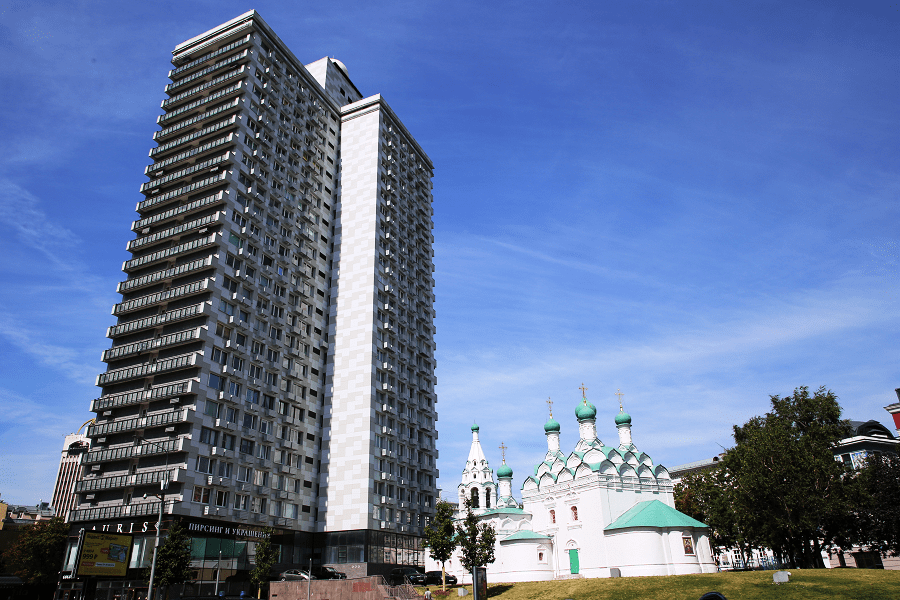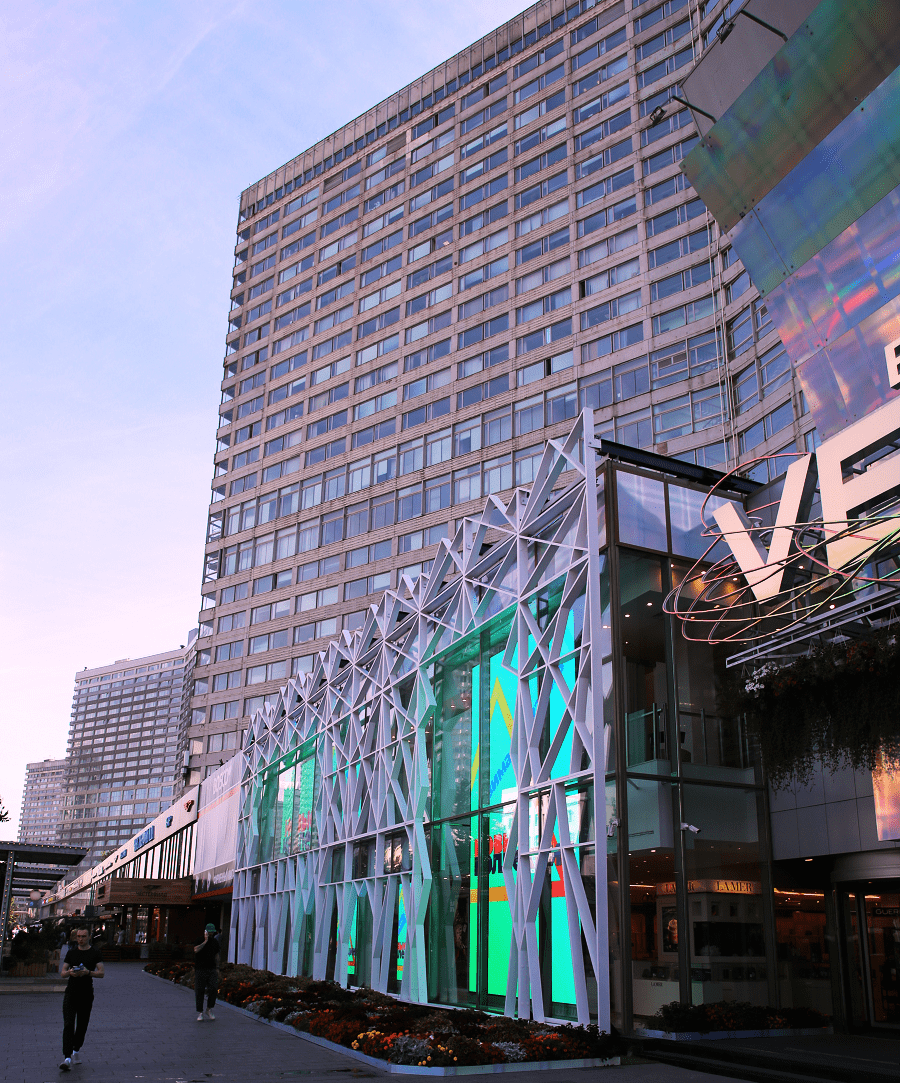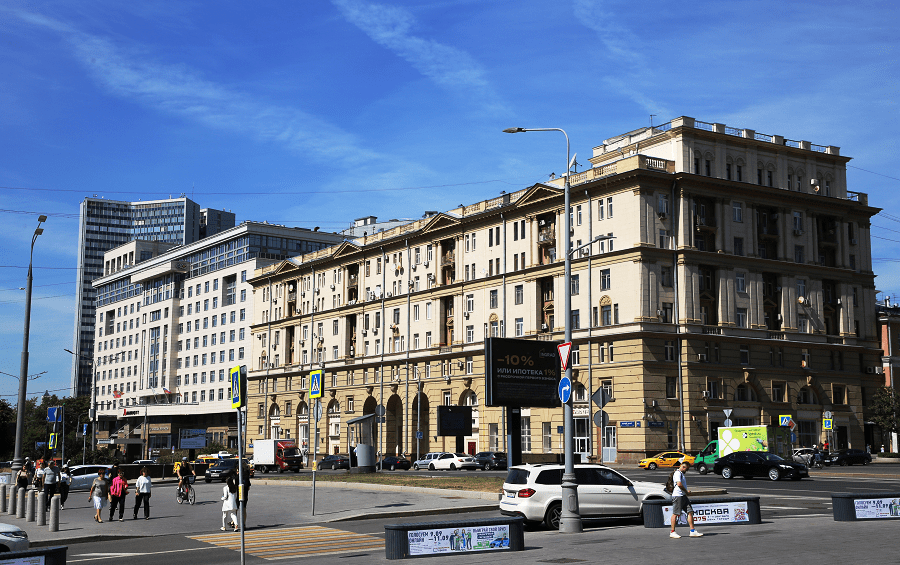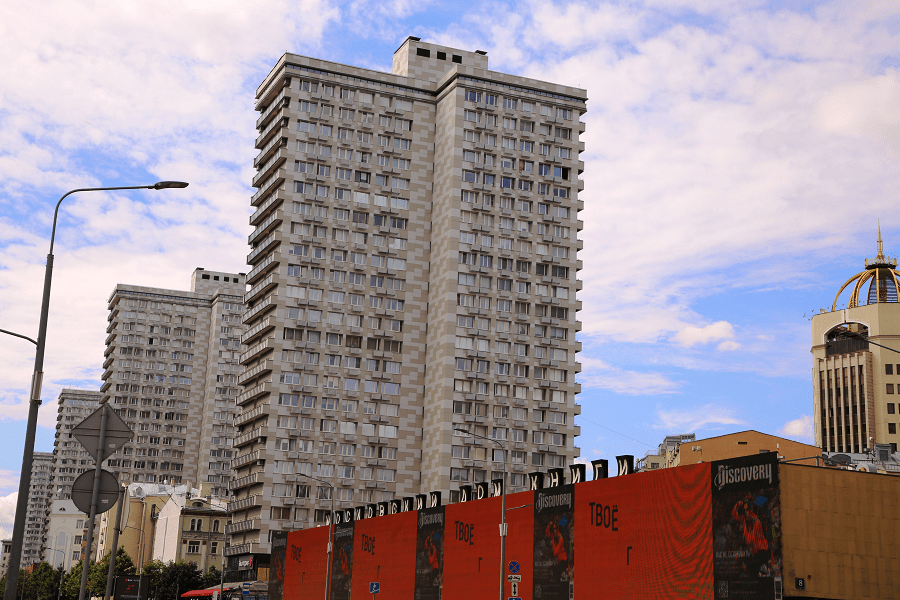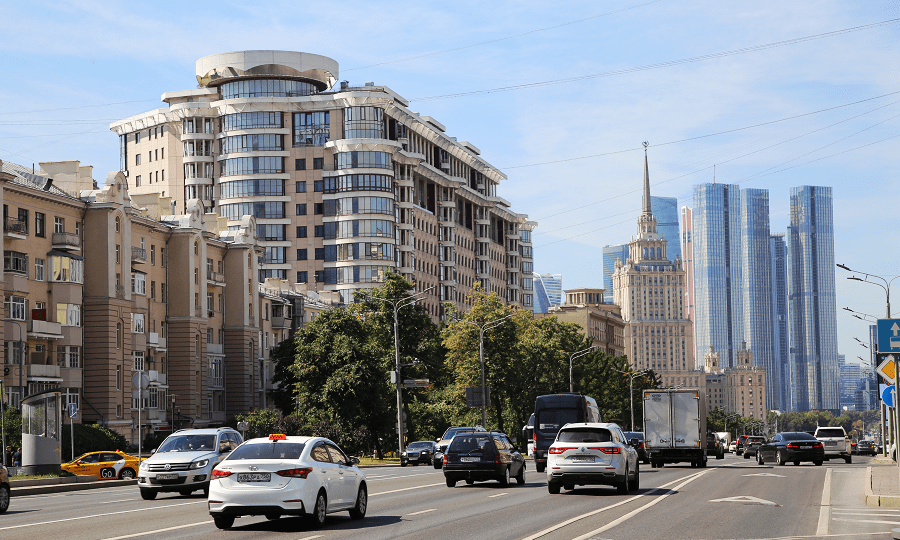New Arbat Avenue (Novy Arbat, in 1963-1990 part of Kalinin Avenue) is a street in the Arbat district of Moscow. It continues Vozdvizhenka Street from Arbat Gate Square and goes to Svobodnaya Rossiya Square, where it passes into the Novoarbatsky Bridge. Part of the federal highway M-1 (Vozdvizhenka Street – Novy Arbat – Kutuzovsky Prospekt – Mozhayskoye Highway – Minskskoye Highway).
The street is named after the neighboring Arbat street. The numbering of houses is conducted from the Arbat Gate Square.
Architecture and main attractions
Section from the Arbat Gate Square to the Garden Ring
The section of Novy Arbat Street from the Arbat Gates to the Garden Ring was built in the 1960s along lanes and streets located between the Arbat and Povarskaya streets (former Krechetnikovsky lane, partly Bolshaya Molchanovka and Malaya Molchanovka).
The ensemble of this section was created in 1962-1968 as part of the project of a group of architects (M. V. Posokhin, A. A. Mndoyants, G. V. Makarevich, B. I. Thor, Sh. A. Airapetov, I. A. Pokrovsky, Yu. Popova and A. Zaitseva). A new large fragment of the urban environment was formed on the avenue, where everything was subordinated to a single plan – from the general direction of the spatial structure to the details of landscaping and advertising.
A dotted line of five 24-story double frame-panel residential towers of the 1-MG-601-Zh series (each with 176 apartments) defined the even (northern) side. High-ranking Soviet officials and representatives of the creative intelligentsia were to settle in these grandiose skyscrapers.
Shops and cafes occupy the first two floors of these buildings. Between the towers, there are two-story buildings (the Book House, the Oktyabr cinema, and the former Khleb store). Low commercial buildings, alternating with vertical residential towers, create a large-scale foreground of the pictures that open before the pedestrian lane. This contrast emphasizes the rise of multi-story buildings.
On the odd (southern) side of Novy Arbat, four 26-story administrative buildings (book houses) were erected, the volumes of which freely rise above the continuous plane of the stylobate connecting them. Together the buildings stretch for 800 meters from Arbatsky Lane to the Garden Ring. The stylobate, which has two ground and two underground floors, houses the lobbies of administrative buildings occupying high volumes and a large shopping center. The building on the odd side was created at the most modern level of functional organization and maintenance of that time.
To solve the problem of unloading goods and products to the shops located here, the architects designed a tunnel 1 km long and 9 m wide, which was built along the entire length of the building with entrances from the ends and the side of two Arbat lanes. The structure did not disturb the daily lives of the population of the area and created convenience for the employees of the shopping centre.
The section from the Garden Ring to the Novoarbatsky bridge
Part of the New Arbat from the Garden Ring to the Novoarbatsky Bridge was laid in 1957 and its appearance has developed over the years. Unlike the main part of Novy Arbat, formed in one decade and according to a single project, this section of Novy Arbat has been in its development since the 1920s (that is, before the emergence of plans to build a highway) to this day.
The first stage in the formation of this section falls in the 1920s–1960s. In 1926-1928 two residential buildings were built on Bolshoy Novinsky Lane (the current address is Novy Arbat, 23 and 25). In 1931-1934, the building of the Institute of Balneology and Physiotherapy was built (architect A.V. Samoilov). After punching a new highway, this building went to its red line. In 1940, as part of the project of architect Alexei Shchusev, a residential building was constructed, securing the corner of the future Novy Arbat and Smolenskaya embankment (Novy Arbat, 31). In the early 1950s, houses were erected at the intersection with the Garden Ring, marking the beginning of this section of the future highway (Novy Arbat, 30 and Novinsky Boulevard, 7). In 1957, these multi-style buildings lined Novy Arbat with new red lines.
In 1963-1970,the COMECON building was designed (Noviy Arbat, 36). After that, for almost three decades, the appearance of this section of Novy Arbat remained unchanged.
A new stage in the formation of this section of Novy Arbat began in the late 1990s. On the odd side, the residential complexes Arbat Tower (building 29, 1998) and Novy Arbat 27 (2009) were built. In 2006, the historical building of the Institute of Balneology was demolished and a multifunctional complex “Novy Arbat, 32” was built in its place.
Nearest metro station
Metro stations “Smolenskaya” (Arbatsko-Pokrovskaya line) and “Smolenskaya” (Filyovskaya line) are located about 400 m from the middle of the avenue.
Metro stations “Arbatskaya” (Arbatsko-Pokrovskaya line) and “Arbatskaya” (Filyovskaya line) are located near the beginning of the avenue.
Nearest attractions: Moscow Zoo, Moscow Planetarium, Residential building on Kudrinskaya Square, Museum-apartment of Pyotr Tchaikovsky, Kudrinskaya square, Chaliapin’s museum, Monument to Brodsky, US embassy, Arbat street, Building of the Ministry of Foreign Affairs, Golden Ring Hotel, AZIMUT City Hotel Smolenskaya, Ukraina Hotel, COMECON building, House of the Government, Church of Simeon Stolpnik on Povarskaya, Khudozhestvenny cinema, Arseny Morozov’s mansion, Vozdvizhenka Street, Gogol boulevard.
See more streets and squares in Moscow, monuments of Moscow, architecture of Moscow.



